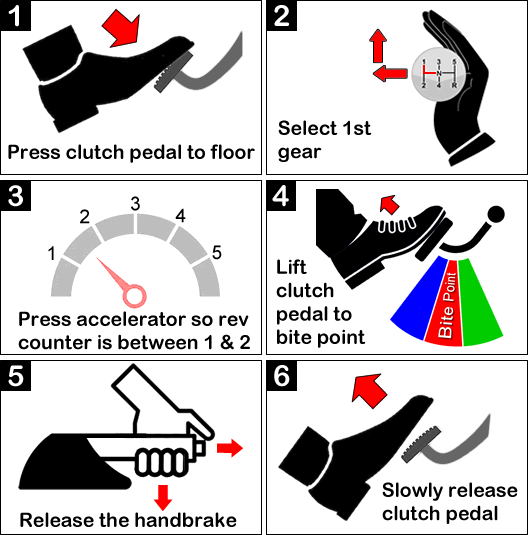Holding the Car on the Clutch Biting Point
Holding the car on the clutch biting point is likely going to be the technique that you’ll first learn with a driving instructor. To start off, what does holding the car on the clutch biting point mean?
In brief, the clutch is made up of two friction discs, one connected to the engine and the other to the gearbox. The two discs separate when you press the clutch pedal, which means the power from the engine is disconnected from the rest of the car. When you lift the pedal, the two friction discs join together, completing the connection of power from the engine, all the way to the wheels.
The clutch biting point is when you begin to raise the clutch pedal and is the moment when the clutch discs begin to join together (see what is the clutch bite point for further details and diagrams). Holding the car on the clutch biting point, with the handbrake on and a little power supplied to the engine (by slightly pressing the accelerator pedal) means the car is stationary, but ready to move off.
Benefit of Holding the Car on the Clutch Biting Point
The benefit of holding the car on the clutch biting point is that there’s a lesser chance of stalling, which is the reason why many instructors teach this method.
Disadvantages of Holding the Car on the Clutch Biting Point
The disadvantages of holding the car on the clutch biting point is that it’s a lot of effort to go through, each and every time you want to move off. Additionally, holding the clutch at the biting point is bad for the clutch. Due to the clutch discs beginning to join, but rotating at different speeds, the friction material heating up and causing wear. Ultimately this will shorten the lifespan of a car’s clutch.
Why Should I Learn how to Hold the Car on the Clutch Biting Point?
You should learn how to hold the car on the clutch biting point because:
- It’s a good technique for early-stage learner drivers to adopt as it helps to prevent stalling when moving off.
- It’s an essential skill to learn for when moving off uphill (hill start) as it prevents the car from rolling backwards.
How to Hold the Car on the Clutch Biting Point
This is the technique used by driving instructors for teaching learner drivers how to move off from a stationary position. This technique helps to prevent stalling. We’ll assume the car is started, the handbrake is on and the gear lever is in neutral.

- Press the clutch pedal fully down to the floor
- Select 1st gear
- Slowly press the accelerator pedal until the needle on the rev counter is between the 1 and 2
- Very slowly lift the clutch and stop when you reach the bite point
- You are now holding the car on the clutch biting point
- When ready, release the handbrake and slowly continue to lift the clutch
- As the car gains momentum, you can fully release the clutch and press a little harder on the accelerator pedal to increase your speed
Tips
- To know when you’ve reached the clutch biting point, listen for a change in the sound of the engine, the car may make a creaking noise and the back of the car may go down a little. For further help and diagrams, see how to find the clutch bite point. The bite point is usually around half way from lifting the clutch pedal up.
- When you release the handbrake, the car will slowly move forwards. As the car gains momentum, you can lift the clutch up all the way, as quickly as you like without fear of stalling.
- You may still stall by using this technique, but don’t worry, it’s normal. Keep practicing – the more you practice, the better you’ll get at it.
Moving Off Without Holding the Car on the Biting Point
Although the technique above is useful for novice learner drivers and is an essential skill to learn for making a hill start, it does become quite tedious and unnecessary for moving off on a level surface. Experienced drivers only use this technique for making a hill start, otherwise they move off much more smoothly by bringing the clutch up, applying the accelerator and releasing the hand brake all at once. For a better all-round driving experience, learn how to move off without using the handbrake.
 Moving Off Without the Handbrake
Moving Off Without the Handbrake